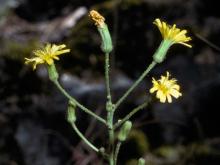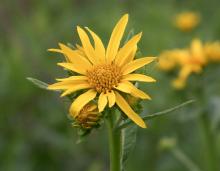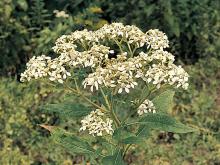Wildflowers, Grasses and Other Nonwoody Plants
Media

Species Types
Scientific Name
Triodanis perfoliata (formerly Specularia perfoliata)
Description
Clasping Venus' looking glass is a single-stemmed plant with purple or blue star-shaped flowers and bluntly toothed, alternate leaves that clasp the stem. It's scattered statewide in a variety of habitats and blooms May-June.
Media

Species Types
Scientific Name
Galium aparine
Description
The tiny white flowers of this native plant are not very memorable, but the curious, sticky-feeling whorls of narrow leaves and lightweight, 4-sided stems make cleavers unique. And then there’s the tiny, round, “Velcro” covered balls of the seeds, which “stick tight” to your socks!
Media

Species Types
Scientific Name
Apocynum cannabinum
Description
Indian hemp is a shrubby, upright perennial with opposite branches and milky sap. This native plant can be a troublesome weed in crop fields and gardens, but Native Americans used its tough, fibrous stems for rope-making.
Media

Species Types
Scientific Name
Packera obovata (formerly Senecio obovatus)
Description
Most common in the Ozarks, round-leaved groundsel is one of seven Packera species in our state. Its showy, bright yellow, daisylike flowers form flat-topped clusters that arise from sparsely leaved stems.
Media

Species Types
Scientific Name
Krigia biflora
Description
There are several members of the aster family that look something like common dandelions. But unlike the familiar lawn weed, two-flowered Cynthia is a native Missouri wildflower.
Media

Species Types
Scientific Name
Hieracium gronovii
Description
A native wildflower of forests, blufftops, glades, pastures, and roadsides, beaked hawkweed looks something like a hairy, yellow-flowering chicory. It is found mostly south of the Missouri River.
Media

Species Types
Scientific Name
Heterotheca camporum (syn. Chrysopsis villosa var. camporum)
Description
Golden aster can cover entire valleys with its bright yellow flowers. It blooms June through October and is scattered mostly south of the Missouri River.
Media

Species Types
Scientific Name
Verbesina helianthoides
Description
Yellow crownbeard and its close relatives are called wingstems because of lengthwise, winged ridges along the stems. Look for it blooming, May through October, in open and rocky areas.
Media

Species Types
Scientific Name
Commelina communis
Description
The flowers of dayflower are truly blue, and they have only two conspicuous petals. A fast-growing, sprawling, but shallow-rooted weed, this introduced species commonly annoys gardeners.
Media

Species Types
Scientific Name
Verbesina virginica
Description
White crownbeard is a tall native perennial wildflower with clusters of white flowerheads. It's called “wingstem” for the narrow green wings running along the stem. It’s called “frostweed” because it forms "frost flowers": strange and beautiful formations at the stem bases after a sudden hard frost.
See Also
About Wildflowers, Grasses and Other Nonwoody Plants in Missouri
A very simple way of thinking about the green world is to divide the vascular plants into two groups: woody and nonwoody (or herbaceous). But this is an artificial division; many plant families include some species that are woody and some that are not. The diversity of nonwoody vascular plants is staggering! Think of all the ferns, grasses, sedges, lilies, peas, sunflowers, nightshades, milkweeds, mustards, mints, and mallows — weeds and wildflowers — and many more!





















